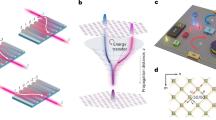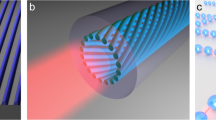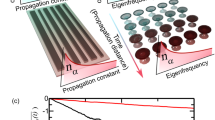Abstract
In recent years, a self-consistent optical thermodynamic framework has emerged that offers a systematic methodology to understand, harness and exploit the complex collective dynamics of multimode nonlinear systems. These developments now allow consideration of a series of long-standing problems in optics, including the prospect of funnelling the entire power flowing in a multimode system into its ground state, for which no methodology currently exists. Here we demonstrate an all-optical Joule–Thomson expansion process mediated by photon–photon interactions whereby the temperature of the optical gas drops abruptly to zero. Our experiments in various configurations of coupled multicore nonlinear waveguide arrangements illustrate how light undergoing expansion-induced cooling can be channelled from arbitrary input states into the fundamental mode with near-unity efficiency. We show that the stability of the post-expansion state is ensured through an irreversible process of energy conversion. The all-optical thermodynamic phenomena explored in this study may enable innovative techniques where various uncorrelated but identical sources are merged into a unified spatially coherent state, offering a route for direct beam combining.
This is a preview of subscription content, access via your institution
Access options
Access Nature and 54 other Nature Portfolio journals
Get Nature+, our best-value online-access subscription
$32.99 / 30 days
cancel any time
Subscribe to this journal
Receive 12 print issues and online access
$259.00 per year
only $21.58 per issue
Buy this article
- Purchase on SpringerLink
- Instant access to full article PDF
Prices may be subject to local taxes which are calculated during checkout




Similar content being viewed by others
Data availability
Source data are provided with this paper. Additional experimental data that support the findings of this study are available from M.S.K. upon reasonable request.
Code availability
The MATLAB codes that support the numerical analysis of this study are available from G.G.P.
References
Chen, Z. & Segev, M. Highlighting photonics: looking into the next decade. eLight 1, 2 (2021).
Ahsan, A. S. & Agrawal, G. P. Graded-index solitons in multimode fibers. Opt. Lett. 43, 3345–3348 (2018).
Eisenberg, H. S., Silberberg, Y., Morandotti, R., Boyd, A. R. & Aitchison, J. S. Discrete spatial optical solitons in waveguide arrays. Phys. Rev. Lett. 81, 3383–3386 (1998).
Malomed, B. A., Mihalache, D., Wise, F. & Torner, L. Spatiotemporal optical solitons. J. Opt. B Quantum Semiclass. Opt. 7, R53–R72 (2005).
Morandotti, R., Peschel, U., Aitchison, J. S., Eisenberg, H. S. & Silberberg, Y. Dynamics of discrete solitons in optical waveguide arrays. Phys. Rev. Lett. 83, 2726–2729 (1999).
Renninger, W. H. & Wise, F. W. Optical solitons in graded-index multimode fibres. Nat. Commun. 4, 1719 (2013).
Segev, M., Crosignani, B., Yariv, A. & Fischer, B. Spatial solitons in photorefractive media. Phys. Rev. Lett. 68, 923–926 (1992).
Ablowitz, M. J., Prinari, B. & Trubatch, A. D. Discrete and Continuous Nonlinear Schrödinger Systems (Cambridge Univ. Press, 2003); https://doi.org/10.1017/CBO9780511546709
Campbell, D. K., Flach, S. & Kivshar, Y. S. Localizing energy through nonlinearity and discreteness. Phys. Today 57, 43–49 (2004).
Longhi, S. Modulational instability and space time dynamics in nonlinear parabolic-index optical fibers. Opt. Lett. 28, 2363–2365 (2003).
Heinrich, M. et al. Observation of three-dimensional discrete-continuous X waves in photonic lattices. Phys. Rev. Lett. 103, 113903 (2009).
Tzortzakis, S., Prade, B., Franco, M. & Mysyrowicz, A. Time-evolution of the plasma channel at the trail of a self-guided IR femtosecond laser pulse in air. Opt. Commun. 181, 123–127 (2000).
Trompeter, H. et al. Bloch oscillations and Zener tunneling in two-dimensional photonic lattices. Phys. Rev. Lett. 96, 053903 (2006).
Morandotti, R., Peschel, U., Aitchison, J. S., Eisenberg, H. S. & Silberberg, Y. Experimental observation of linear and nonlinear optical Bloch oscillations. Phys. Rev. Lett. 83, 4756–4759 (1999).
Pourbeyram, H., Agrawal, G. P. & Mafi, A. Stimulated Raman scattering cascade spanning the wavelength range of 523 to 1750 nm using a graded-index multimode optical fiber. Appl. Phys. Lett. 102, 201107 (2013).
Boyd, R. W. & Gaeta, A. L. in Laser Optics of Condensed Matter (eds Garmire, E. et al.) 99–105 (Springer, 1991); https://doi.org/10.1007/978-1-4615-3726-7_15
Podivilov, E. V. et al. Hydrodynamic 2D turbulence and spatial beam condensation in multimode optical fibers. Phys. Rev. Lett. 122, 103902 (2019).
Zakharov, V. E., L’vov, V. S. & Falkovich, G. Kolmogorov Spectra of Turbulence I (Springer, 1992); https://doi.org/10.1007/978-3-642-50052-7
Klaers, J., Schmitt, J., Vewinger, F. & Weitz, M. Bose–Einstein condensation of photons in an optical microcavity. Nature 468, 545–548 (2010).
Wu, F. O., Hassan, A. U. & Christodoulides, D. N. Thermodynamic theory of highly multimoded nonlinear optical systems. Nat. Photon. 13, 776–782 (2019).
Picozzi, A. Towards a nonequilibrium thermodynamic description of incoherent nonlinear optics. Opt. Express 15, 9063–9083 (2007).
Aschieri, P., Garnier, J., Michel, C., Doya, V. & Picozzi, A. Condensation and thermalization of classsical optical waves in a waveguide. Phys. Rev. A 83, 033838 (2011).
Makris, K. G., Wu, Fan, O., Jung, P. S. & Christodoulides, D. N. Statistical mechanics of weakly nonlinear optical multimode gases. Opt. Lett. 45, 1651–1654 (2020).
Ramos, A., Fernández-Alcázar, L., Kottos, T. & Shapiro, B. Optical phase transitions in photonic networks: a spin-system formulation. Phys. Rev. X 10, 031024 (2020).
Baudin, K. et al. Classical Rayleigh-Jeans condensation of light waves: observation and thermodynamic characterization. Phys. Rev. Lett. 125, 244101 (2020).
Shi, C., Kottos, T. & Shapiro, B. Controlling optical beam thermalization via band-gap engineering. Phys. Rev. Res. 3, 033219 (2021).
Wu, F. O. et al. Thermalization of light’s orbital angular momentum in nonlinear multimode waveguide systems. Phys. Rev. Lett. 128, 123901 (2022).
Jung, P. S. et al. Thermal control of the topological edge flow in nonlinear photonic lattices. Nat. Commun. 13, 4393 (2022).
Ferraro, M., Mangini, F., Zitelli, M. & Wabnitz, S. On spatial beam self-cleaning from the perspective of optical wave thermalization in multimode graded-index fibers. Adv. Phys. X 8, 2228018 (2023).
Mangini, F., Ferraro, M., Tonello, A., Couderc, V. & Wabnitz, S. High-temperature wave thermalization spoils beam self-cleaning in nonlinear multimode GRIN fibers. Opt. Lett. 48, 4741–4744 (2023).
Mangini, F. et al. Statistical mechanics of beam self-cleaning in GRIN multimode optical fibers. Opt. Express 30, 10850–10865 (2022).
Pourbeyram, H. et al. Direct observations of thermalization to a Rayleigh–Jeans distribution in multimode optical fibres. Nat. Phys. 18, 685–690 (2022).
Fusaro, A., Garnier, J., Krupa, K., Millot, G. & Picozzi, A. Dramatic acceleration of wave condensation mediated by disorder in multimode fibers. Phys. Rev. Lett. 122, 123902 (2019).
Barviau, B. et al. Experimental signature of optical wave thermalization through supercontinuum generation in photonic crystal fiber. Opt. Express 17, 7392–7406 (2009).
Podivilov, E. V. et al. Thermalization of orbital angular momentum beams in multimode optical fibers. Phys. Rev. Lett. 128, 243901 (2022).
Marques Muniz, A. L. et al. Observation of photon-photon thermodynamic processes under negative optical temperature conditions. Science 379, 1019–1023 (2023).
Baudin, K. et al. Observation of light thermalization to negative-temperature Rayleigh-Jeans equilibrium states in multimode optical fibers. Phys. Rev. Lett. 130, 063801 (2023).
Pyrialakos, G. G., Ren, H., Jung, P. S., Khajavikhan, M. & Christodoulides, D. N. Thermalization dynamics of nonlinear non-Hermitian optical lattices. Phys. Rev. Lett. 128, 213901 (2022).
Ren, H. et al. Nature of optical thermodynamic pressure exerted in highly multimoded nonlinear systems. Phys. Rev. Lett. 131, 193802 (2023).
Ren, H. et al. Dalton’s law of partial optical thermodynamic pressures in highly multimoded nonlinear photonic systems. Opt. Lett. 49, 1802–1805 (2024).
Pathria, R. K. & Beale, P. D. Statistical Mechanics (Academic, 2022).
Selim, M. A., Wu, F. O., Pyrialakos, G. G., Khajavikhan, M. & Christodoulides, D. Coherence propertiesof light in highly multimoded nonlinear parabolic fibers under optical equilibrium conditions. Opt. Lett. 48, 1208–211 (2023).
Szameit, A. & Nolte, S. Discrete optics in femtosecond-laser-written photonic structures. J. Phys. B: Mol. Opt. Phys. 43, 163001 (2010).
Gerchberg, R. W. A new approach to phase retrieval of a wave front. J. Mod. Opt. 49, 1185–1196 (2002).
Shapira, O., Abouraddy, A. F., Joannopoulos, J. D. & Fink, Y. Complete modal decomposition for optical waveguides. Phys. Rev. Lett. 94, 143902 (2005).
Schwartz, T., Bartal, G., Fishman, S. & Segev, M. Transport and Anderson localization in disordered two-dimensional photonic lattices. Nature 446, 52–55 (2007).
Trotzky, S. et al. Probing the relaxation towards equilibrium in an isolated strongly correlated one-dimensional Bose gas. Nat. Phys. 8, 325–330 (2012).
Anglin, J. R. & Ketterle, W. Bose–Einstein condensation of atomic gases. Nature 416, 211–218 (2002).
Mirhosseini, M., Sipahigil, A., Kalaee, M. & Painter, O. Superconducting qubit to optical photon transduction. Nature 588, 599–603 (2020).
Rückriegel, A. & Kopietz, P. Rayleigh-Jeans condensation of pumped magnons in thin-film ferromagnets. Phys. Rev. Lett. 115, 157203 (2015).
Acknowledgements
We thank C. Otto for preparing the high-quality fused silica samples used for the inscription of all photonic structures employed in this work. A.S. acknowledges funding from the Deutsche Forschungsgemeinschaft (grants SZ 276/9-2, SZ 276/19-1, SZ 276/20-1, SZ 276/21-1, SZ 276/27-1 and GRK 2676/1-2023 ‘Imaging of Quantum Systems’, project no. 437567992). A.S. also acknowledges funding from the Krupp von Bohlen and Halbach Foundation as well as from the FET Open Grant EPIQUS (grant no. 899368) within the framework of the European H2020 programme for Excellent Science. A.S. and M.H. acknowledge funding from the Deutsche Forschungsgemeinschaft by means of SFB 1477 ‘Light–Matter Interactions at Interfaces’ (project no. 441234705). T.A.W.W. is supported by a European Commission Marie Skłodowska-Curie Actions Individual Fellowship ‘Quantum correlations in PT-symmetric photonic integrated circuits’, project no. 895254. This work was partially supported by the following agencies and organizations: W.M. Keck Foundation, Israel Ministry of Defense (4441279927), MPS Simons Collaboration (733682), National Science Foundation (CCF-2320937), Army Research Office (W911NF-23-1-0312), Office of Naval Research (N00014-20-1-2789), Air Force Office of Scientific Research (FA9550-20-1-0322, FA9550-21-1-0202), US Air Force Research Laboratory (FA86511820019, FA8650-19-C-1692) and the Department of Energy (DE-SC0022282, DE-SC0025224).
Author information
Authors and Affiliations
Contributions
G.G.P and D.N.C initiated the idea. G.G.P conceived the theoretical framework. M.S.K. and J.B. designed and fabricated the samples. The experimental set-up was constructed by M.S.K., T.A.W.W. and M.H. The measurements were conducted by M.S.K. Numerical simulations were performed by G.G.P, M.A.S., H.R. and P.S.J. The obtained data were evaluated and interpreted by M.S.K., R.A., M.H. and G.G.P. M.K., A.S. and D.N.C. supervised the efforts of their respective groups.
Corresponding authors
Ethics declarations
Competing interests
The authors declare no competing interests.
Peer review
Peer review information
Nature Physics thanks Vincent Couderc and the other, anonymous, reviewer(s) for their contribution to the peer review of this work.
Additional information
Publisher’s note Springer Nature remains neutral with regard to jurisdictional claims in published maps and institutional affiliations.
Extended data
Extended Data Fig. 1 Expansion in the presence of losses: BPM simulations.
(a) In an ideal lossless system, the overall power is conserved, and the total power contained in the fundamental mode steadily grows during the cooling process. (b) The presence of losses introduces a global power decay (dashed red line), but the relative fraction of power contained in the fundamental mode (solid blue line) at a given propagation distance nevertheless increases as nonlinear expansion proceeds. As shown in Fig. 3b, even in the presence of significant propagation losses attenuation 0.3 dB/cm, a value beyond the typical losses of 0.4 dB/cm for laser-written waveguides in fused silica, the efficiency of the JT power transfer to the ground state only decreases by approximately 10%.
Extended Data Fig. 2 Nonlinear dynamics in the (b) square and (a,c) triangular lattices: tight-binding simulations.
In all lattices, light was injected from a single site with peak power favoring a JT irreversible expansion, just below the threshold of self-focusing collapse. The average (Rayleigh-Jeans) conversion efficiency to the fundamental mode is 85.3%, 79.3% and 91% for the, triangular (hexagonal), square, and triangular (irregular) lattice, respectively. An irreversible exchange of energy is observed between \(U\) and \({H}_{{NL}}\), matching almost perfectly with theoretical prediction. The teal dashed line represents Eq. 4 while the teal solid line includes a correction term, \({U}_{L}=-1/2{P}^{2}+{H}_{{NL},\min }=-1/2{P}^{2}+1/(2M){P}^{2}\).
Supplementary information
Supplementary Information
Supplementary Figs. 1–10 and Sections 1–8.
Source data
Source Data
Source data Figs. 1, 3 and 4 and Extended Data Figs. 1 and 2.
Rights and permissions
Springer Nature or its licensor (e.g. a society or other partner) holds exclusive rights to this article under a publishing agreement with the author(s) or other rightsholder(s); author self-archiving of the accepted manuscript version of this article is solely governed by the terms of such publishing agreement and applicable law.
About this article
Cite this article
Kirsch, M.S., Pyrialakos, G.G., Altenkirch, R. et al. Observation of Joule–Thomson photon-gas expansion. Nat. Phys. 21, 214–220 (2025). https://doi.org/10.1038/s41567-024-02736-1
Received:
Accepted:
Published:
Issue date:
DOI: https://doi.org/10.1038/s41567-024-02736-1
This article is cited by
-
Thermalized light finds its way
Nature Photonics (2025)
-
Universal routing of light via optical thermodynamics
Nature Photonics (2025)
-
Photon–photon chemical thermodynamics of frequency conversion processes in highly multimode systems
Light: Science & Applications (2025)



